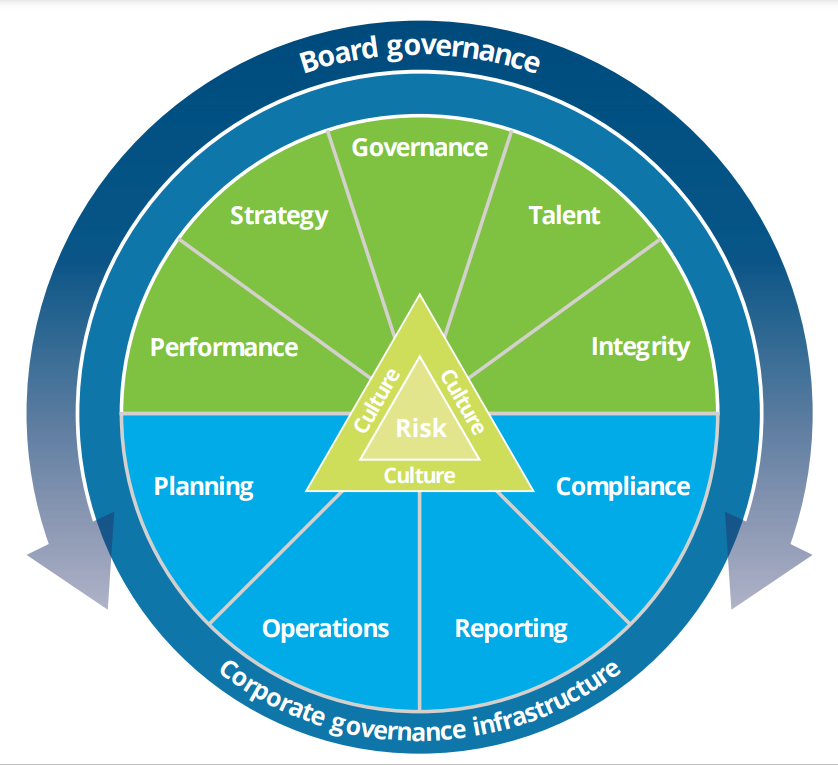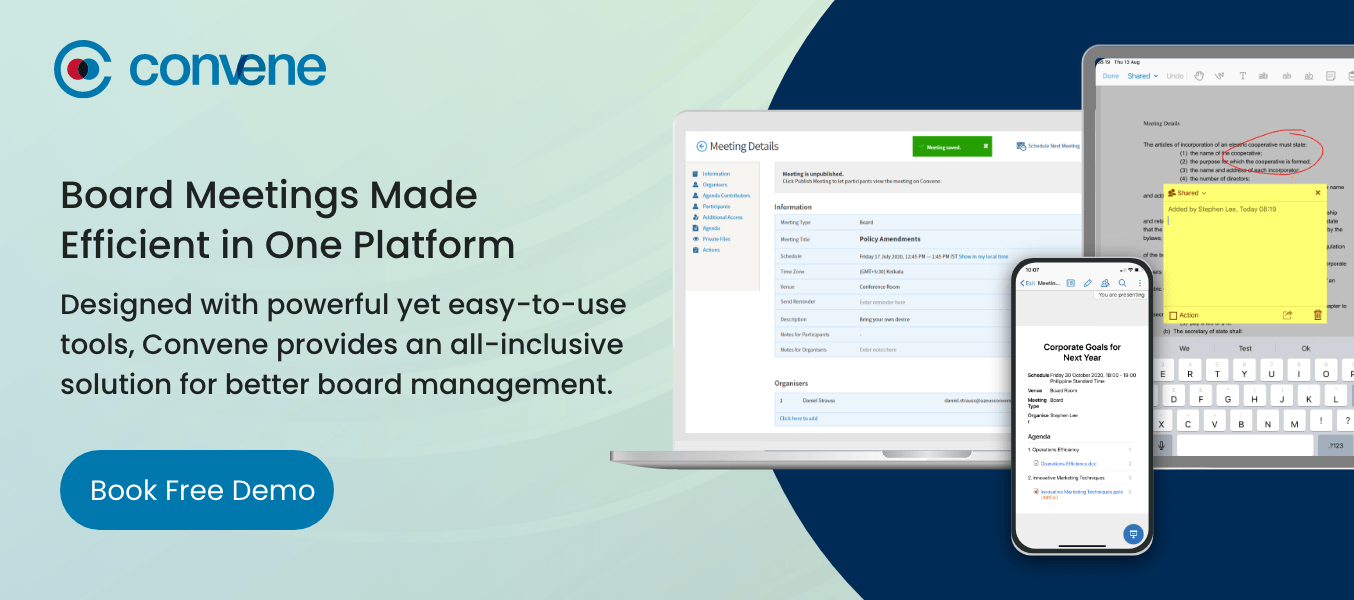Governance is no doubt one of the most important foundations of any board. It supports an organization in strategizing and achieving its goals, creating rightful operational policies and practices, and setting controls that guide corporate behavior. The simplest board governance definition relates to a set of rules and regulations that govern the growth and success of a business.
Organizations that seek to have exceptional board governance face numerous challenges, including a lack of clear organizational strategy, conflict of interests, growing complexity in compliance, and poorly established boards.
Being able to overcome these challenges and achieve good board governance can result in robust decision-making and overall company success. Read on to better understand what board governance is all about and how an organization can employ it.
Pillars of Good Board Governance
In today’s corporate landscape, board governance has gained brighter limelight, making it at the top of an organization’s priorities and goals. Good governance guides the board in managing business functions, while steering clear of compliance and legal issues.
As a significant aspect of underpinning an organization’s efficiency and integrity, applying these pillars of good board governance is imperative.
Responsibility
Good governance can start when the board of directors accepts their full responsibilities. They must understand the powers they hold and the authority that they exercise. There are several duties that impose responsibility on the board, and any contravention can cause penalization under certain provisions. In general, the board is responsible for overseeing the management of the company and its affairs and shepherding it away from risks but towards success.
Below are the main responsibilities of the board of directors in upholding good governance practices and policies:
- Create an effective strategic plan that aligns with the organization’s mission
- Put mechanisms in place to track the organization’s progress against the goals
- Determine how to capitalize on opportunities while managing real threat
- Work collectively with the management during times of crisis
- Be aware of the local, federal, and state laws that the organization must adhere to
- Act as responsible stewards of the company’s finances and deliver sufficient financial oversight
- Demonstrate deep passion and support to the broader community to improve the company’s public standing
- Select the right executive director and conduct an annual evaluation to make sure they fulfill their obligations
Transparency
A company and its board are expected to inform its shareholders about the entity’s plans, activities, and risks involved. Transparency refers to the willingness to disclose business strategies and financial performance figures to the rightful shareholders. And the board should make sure all this information is accurate and updated.
In order to maintain governance, the board should also ensure timely disclosure of such material matters and that they reflect the company’s social, environmental, and financial standing. The board of directors should also assure full disclosure of identified risks and implement systematic oversight of the management of such conflicts.
In a simpler manner, transparency is present on a board if the material information is accessible to the individuals that need them for making informed decisions. The available information should also be easy to understand by the involved individuals.
Impartiality
Good governance requires impartiality from the board. The board of directors is expected to make decisions with an independent approach — without getting influenced by any personal or external interests that can jeopardize the business decision. To make this happen, the board must disregard anything that can cloud their objectivity or can influence their responsibilities, may it be personal interests or close colleagues.
The board should also exhibit fairness among the company’s shareholders, including its employees and the community it serves. The fairer that organization and its board appear, the more likely it can overcome the scrutiny or pressure of different parties.
Accountability
In a nutshell, accountability enables an organization to operate productively and effectively. Unless the board of directors accepts and understands their duties, good governance is incredibly challenging to achieve. Accountability is an important facet of corporate governance, as it encompasses high levels of honesty and integrity.
Accountability involves both internal and external. Internal accountability often deals with the prevention of misuse of powers and reviewing the effectiveness of internal controls or systems. External accountability, on the other hand, refers to compliance with legal provisions and the organization’s accountability to external shareholders.
Misuse of powers and resources can occur if accountability is non-existent. An accountable board of directors should:
- Determine and understand the nature and extent of organizational risks
- Uphold proper internal control systems and sound risks management
- Establish a balanced and fair evaluation of the company’s standing and prospects
- Create a transparent plan for corporate reporting and risk management
- Maintain a good relationship with stakeholders, and face scrutiny from stakeholders
Security
Among the critical aspects of board governance is security. Governance plays a major role in establishing effective administrative controls to identify and mitigate risks. The involvement of the board is necessary for risk oversight and management. This requires boards to keep pace with the rapidly changing cyber-threat landscape for them to obtain successful governance at the board level.
Strengthening cybersecurity and resilience also requires boards to be aware of and prepare for the proliferating regulations around cybersecurity. It is part of their fiduciary responsibility to ensure cyber protection, and create a strategic plan for recovery and business continuation in case a cyber incident occurs.
It is best to consider that regulators hold boards accountable in cybersecurity matters. Ignoring such governance issues can invite more scrutiny from regulators, in which boards are likely to also face litigation. To prevent this, the board of directors should understand the constantly changing legal and regulatory environments, and address the knowledge gaps keeping them from protecting the company’s interests from threats.
Board Governance Models
Governance models offer structures the board can use or modify to help them in fulfilling their governance roles and responsibilities. Such models enable the board to better manage organizational structure and mechanisms by which governance is employed. Below are the corporate and nonprofit governance models that boards should understand.
Corporate Governance Models
- Anglo-Saxon Model — Also known as the shareholder-oriented model, the Anglo-Saxon Model is characterized by the dominance of independent individuals and individual shareholders. Boards that follow this model involve both “insiders” (executives or employees hired by the company and “outsiders” (individuals who have no direct relationship with the corporation).
- The German Model — Governing the German and Austrian corporations, the German Model prescribes two boards — also known as the two-tier board model. First is the supervisory board composed of shareholder and employee representatives, and the second one is the management board primarily composed of insiders.
- The Japanese Model — Similar to the German Model, the Japanese Model is based on internal control and focuses on the existence of strategic shareholders instead of capital market influence. Boards in this model are composed of insiders, such as executive managers, so non-affiliated shareholders hold little or no voice in this governance model.
Nonprofit models
- Advisory Model — Boards that implement the Advisory Model function in the service of the CEO of the corporation. Members of the board are entrusted to share their knowledge and counsel with the CEO, enabling profitable decisions for the organization.
- Patron Governance Model — Nonprofit boards in this model offer financial support and contributions to the organization. As this model is heavily focused on fundraising, members of the board are selected based on their wealth and influence in the community.
- Management Team Model — A recognized structure even in for-profit enterprises, nonprofit boards that use this model divide themselves into different committees to oversee certain business aspects such as human resources, finance, fundraising, planning, and programs and activities.
- Cooperative Model — Boards that employ the Cooperative Model do not have a CEO or a manager in their firm. Considered the most democratic governance model, all decisions come from the consensus of the board.
- Policy Model — The Policy Model identifies the board and the CEO as two distinct entities. The board acts as an aid in the company and sits behind the CEO during the decision-making phase.
Board Governance Framework
A board governance framework is vital for implementing operational and risk management, and establishing accountability and compliance within the organization. It also helps the board in making well-thought, data-based decisions that influence how the company will carry out growth aspirations and strategic direction, and adapt to the ever-changing business landscape.
In addition, a good board governance framework can present a culture of excellence and transparency in the entire organization. Other benefits include smoother-running operations, visibility of errors or nonconformities in processes, and guaranteed compliance.
In creating a board governance framework, it is important to consider aspects such as the type of organization, board structure and responsibilities, information that need to access and flow, and so on. Below is a governance framework developed by Deloitte that illustrates an end-to-end view of corporate governance and a basis for helping boards determine potential opportunities.

The Deloitte Governance Framework
Convene Supports Good Board Governance Framework
Convene is a board governance software committed to providing a digital space to store and access data essential to facilitating good governance. Aiming to improve board productivity and collaboration, Convene simplifies document management, board meetings, and decision-making, giving the board the correct tools to develop a good governance framework that guides their organization processes and operations. Learn more about how Convene can leverage your board governance framework and protect your stakeholder’s interests.
Jielynne is a Content Marketing Writer at Convene. With over six years of professional writing experience, she has worked with several SEO and digital marketing agencies, both local and international. She strives in crafting clear marketing copies and creative content for various platforms of Convene, such as the website and social media. Jielynne displays a decided lack of knowledge about football and calculus, but proudly aces in literary arts and corporate governance.










